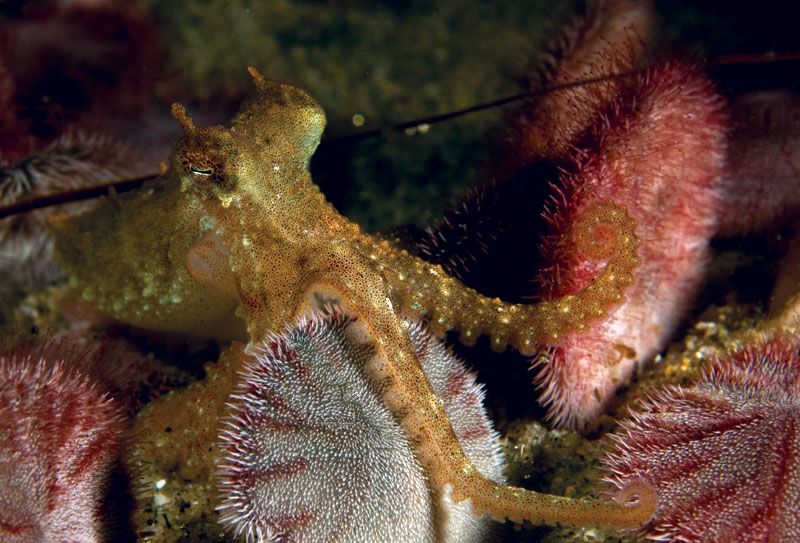Words and Photos by Mike Bartick.
For me, photography has been a never-ending learning curve. It’s a sometimes frustrating and always challenging craft that hooked me when I picked up my first brownie box camera in the eighth grade. A lot has changed in the realm of camera equipment since then, but my inquisitive nature has remained the same. Along with my natural desire for discovery and challenge, this innate curiosity is largely what compelled me to become an underwater photographer. Since that fateful eighth grade day, filling my viewfinder with small subjects has been an obsession.
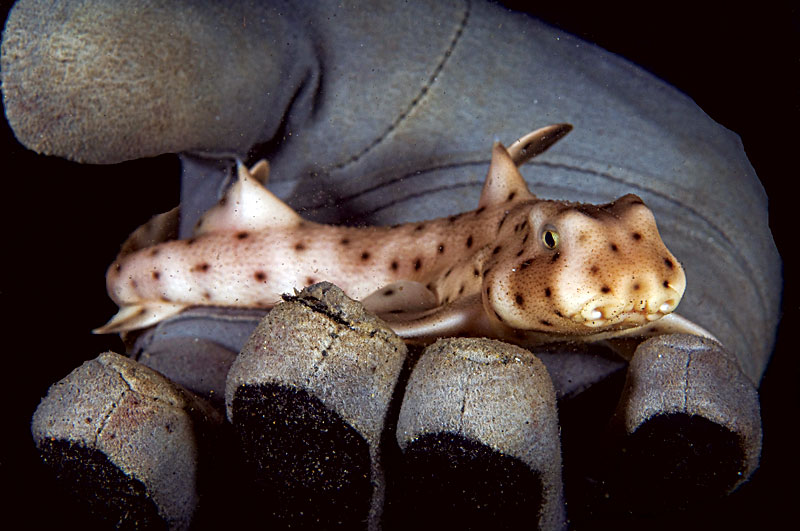 The turbid, nutrient-rich waters of California make wide-angle photography a challenge, and I’ve found that macro photography has been the most reliable technique for catching great images in local waters. Some may say macro photography is the easiest way to learn underwater photography. While this may not be the case for everyone, macro photography can be more accessible for many divers, and an easy way for the aspiring photographer to begin shooting vibrant underwater photos.
The turbid, nutrient-rich waters of California make wide-angle photography a challenge, and I’ve found that macro photography has been the most reliable technique for catching great images in local waters. Some may say macro photography is the easiest way to learn underwater photography. While this may not be the case for everyone, macro photography can be more accessible for many divers, and an easy way for the aspiring photographer to begin shooting vibrant underwater photos.
So what is macro photography? Defined, macro photography is taking photographs from a vantage point that is very close to the subject, allowing photographers to shoot small objects at a 1:1 ratio and portray the subject in true life-size. Special lenses are frequently used to achieve clear focus from distances as small as inches.
Macro photography can be practiced using small-scale point-and-shoot cameras or larger SLR cameras. Lighting is generally provided by underwater lights called strobes that work to illuminate natural colors that are otherwise lost at depth. Camera systems can range in cost from a few hundred dollars to thousands of dollars, depending on the model, features, and accessories. Both types of cameras have their own set of advantages and drawbacks.
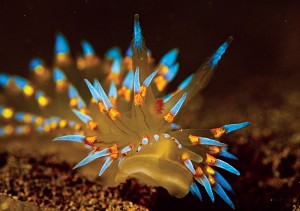 Let’s take a look at some of the elements that make a great macro photo:
Let’s take a look at some of the elements that make a great macro photo:
- Sharpness – Even with great Photoshop skills, there is just no way to salvage a soft, out-of-focus photo. Sharp photos can be achieved by adjusting your distance from the subject, increasing your shutter speed, stabilizing the camera, and taking the time to slow down once underwater. Fast-moving subjects naturally require fast shutter speeds, while slower, more static subjects shoot best at a slower shutter speed. While it definitely takes practice, the right combination of focus, distance, camera stability, and shutter speed results in a sharp macro shot.
- Composition – Literally volumes of books exist on this subject. Concepts such as the rule of thirds, Fibonacci’s law, and geometric shape are worth studying in order to improve your eye for strong photo composition. Continually shooting all your subjects in a “bull’s-eye” fashion can become visually mundane. If all your photos tend to have the same composition, try to focus and recompose your shots. The focus points in your photo can be moved around to highlight specific areas of your subject. For example, you may want to make the sharpest point of your image the eyes of an eel, or the rhinophores of a nudibranch. Experimenting with different compositions and techniques will help you to develop your own unique photographic style.
- Depth of Field – Depth-of-field is another term used often in macro photography. Depth-of-field usually refers to the portion of the photo that is acceptably sharp, while other areas are out of focus. In macro photography, a lens can only achieve a precise focus at one given point. The decrease in sharpness before and after that point is gradual and controlled by the aperture or lens magnification. The aperture of a lens is the diameter of the lens opening, and is usually controlled by an iris. The larger the diameter of the aperture, the more light reaches the image sensor. When setting the camera’s aperture, a smaller number (such as f3.5) means a larger opening or aperture, which results in the least possible depth-of-field. A higher number (such as f22) indicates a smaller opening or aperture, creating a much greater depth-of-field.
In terms of lens magnification, the closer you get to the subject, the less depth-of-field will result. This holds true regardless of lens size. Selectively using depth-of-field is a great way to define a photo and create a visually compelling image by adding another dimension to your shot.
SUBSCRIBE TODAY and learn more from Mike Bartick on underwater photography in the next issue of California Diver Magazine!
In addition to understanding how to manipulate and use equipment creatively in macro photography, mastery of technique, procedures and methods is essential to the craft. Improving technique requires a lot of practice and even more time. Below are a few key concepts that can help you shoot exciting underwater photos.
- Contrast – Contrast is an effective way to create visual depth in a photo. By using contrasting patterns and colors, shapes and sizes and experimenting with lightness and darkness, your subject will achieve more definition and separate itself from the background. Creating this sense of dimension and adding perspective is especially important when shooting small subjects in macro photography.
- Lighting – In macro photography, lighting is perhaps the most overlooked element of all. Successful lighting creates a certain tone or mood in a photograph. When shooting underwater, colors are literally painted onto the photo via lighting. Many underwater photographers use both natural (ambient) lighting and supplemental light (on-camera strobes) to create the best exposure. Remember, the deeper you go, the fewer natural colors are visible without the use of an external light source.
- Getting Close and Getting Low – I find that getting close and low is essential in achieving a clean and impressive photo. Getting close to your subject eliminates distance and thus water between your lens port and your subject. Getting low also tends to create good negative space, which adds a distinctive perspective to a photograph. This is an excellent technique to practice when framing your macro subject.
- Backscatter – Backscatter is the dreaded nemesis of the underwater photographer. Often times in California waters, there are particulates floating between the camera and the subject, which create distracting elements in your photos. Once in while, the conditions will turn for the better and temporarily bless Californian macro photographers with warm, clean water conducive to exceptional shots. But for the most part, the nutrient-rich waters of the California coast are everything but clear and warm. Often times particulates are unavoidable where you’re diving, so do your best to get as close to your subject as possible, then adjust your lighting in attempt to avoid highlighting the irksome particles. If the particles are especially thick and persistent, moving to a different area or dive site where the water is cleaner may be necessary.
- Diopters, Teleconverter and Extension Tubes – These three tools generally help underwater photographers with magnification, but will also affect the final outcome of a photograph in different ways. Diopters are used at the end of the lens, and tend to require more light, resulting in a narrower depth-of-field. Teleconverters and extension tubes work in much of the same way. They’re placed between the camera body and lens, extending the distance from the back of the lens to the sensor to increase magnification. Note that losing light and narrowing your depth-of-field are disadvantages, so other adjustments might need to be made (such as exposure) to compensate.
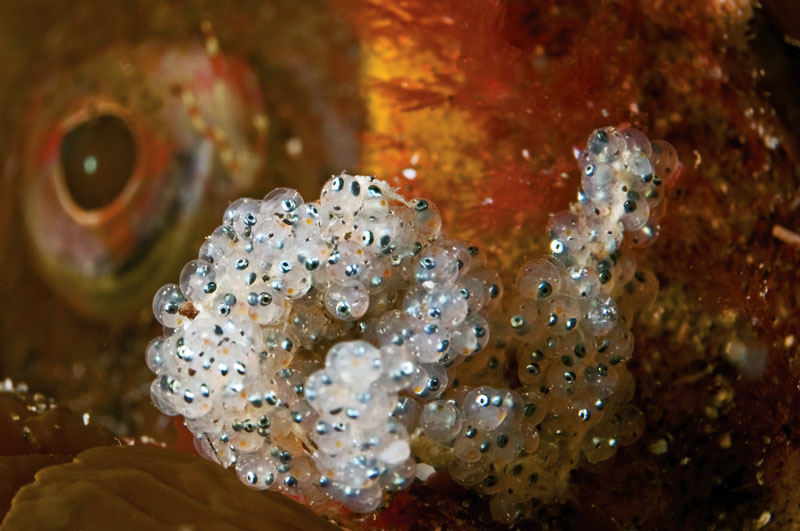 Finding a subject to photograph requires an entirely different set of skills. Doing some homework and researching the habits of your potential subjects before entering the water will help you avoid spending the greater part of your dive searching for your subject. Underwater photography is anything but simple, so the more time you spend with your subject the better your photographs will turn out. Before I take a trip, I study my destination and learn about the creatures that live there. I read up on when and where they are most commonly found, their food sources, their mating habits, and any other information that can potentially help me access them. I also create a “critter list” which I study every morning and use to guide me on my dives. In many cases I’ll e-mail the list in advance to the dive guides working at my destination and have them look for the animals ahead of time so I have an easier time finding them when I arrive.
Finding a subject to photograph requires an entirely different set of skills. Doing some homework and researching the habits of your potential subjects before entering the water will help you avoid spending the greater part of your dive searching for your subject. Underwater photography is anything but simple, so the more time you spend with your subject the better your photographs will turn out. Before I take a trip, I study my destination and learn about the creatures that live there. I read up on when and where they are most commonly found, their food sources, their mating habits, and any other information that can potentially help me access them. I also create a “critter list” which I study every morning and use to guide me on my dives. In many cases I’ll e-mail the list in advance to the dive guides working at my destination and have them look for the animals ahead of time so I have an easier time finding them when I arrive.
SLR’s vs. Compact Cameras
Although I shoot with an SLR, I look at many of the photos taken with compact cameras and admire the depth-of-field in those images. There is certainly an excellent depth-of-field with point-and-shoot cameras that is difficult to achieve with an SLR. And just to add insult to injury, now you can shoot high-definition video with a happy snappy too!
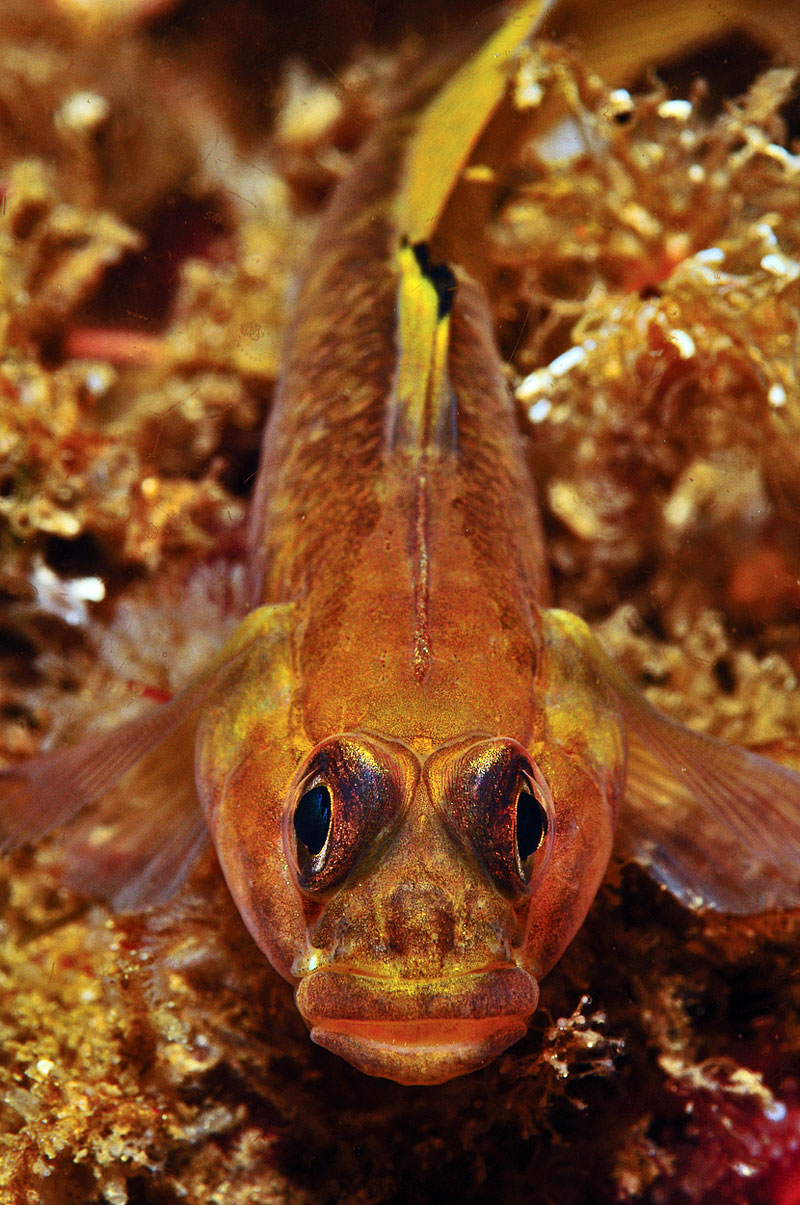 So why choose an SLR over a compact camera? I suppose it’s mostly personal preference. As for myself, I like the resolution, sharpness and the freedom of lens choice that an SLR camera offers. And I value the complete control over lighting, the responsive shutter and the ability to frame my photo through a viewfinder that an SLR camera provides.
So why choose an SLR over a compact camera? I suppose it’s mostly personal preference. As for myself, I like the resolution, sharpness and the freedom of lens choice that an SLR camera offers. And I value the complete control over lighting, the responsive shutter and the ability to frame my photo through a viewfinder that an SLR camera provides.
Next time you set out to shoot macro photos at your favorite dive site, remember these tips: utilize the depth-of-field by changing your aperture, spend time composing your shots, change the contrast with the strobe power, get close and low, and take your time.
Albert Einstein once defined insanity as “doing the same thing over and over again and expecting different result.” If you want to change the look of your photos, then you must change the way you shoot them. Remember to challenge yourself and always have fun!
Mike Bartick is an editor for California Diver Magazine and an experienced professional underwater photographer. Visit his website at saltwaterphoto.com, or drop him an email here.
SUBSCRIBE TODAY and learn more from Mike Bartick on underwater photography in the next issue of California Diver Magazine!
All copy and photos ©Copyright 2011 by California Diver Magazine and the original author. No contents may be reproduced in any form without prior written permission.
.

